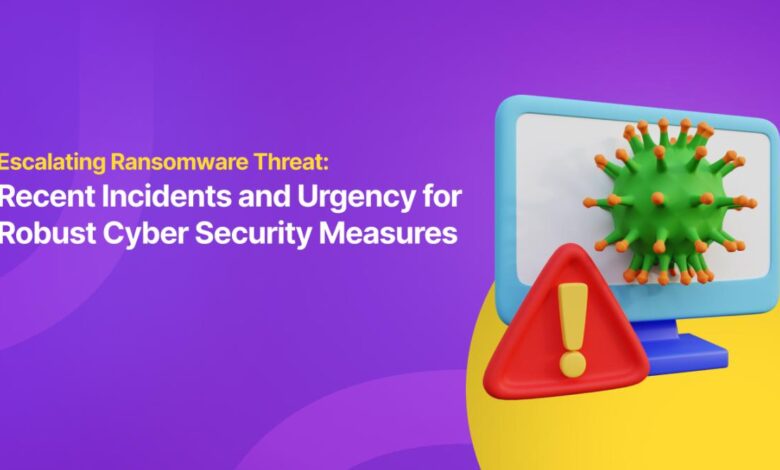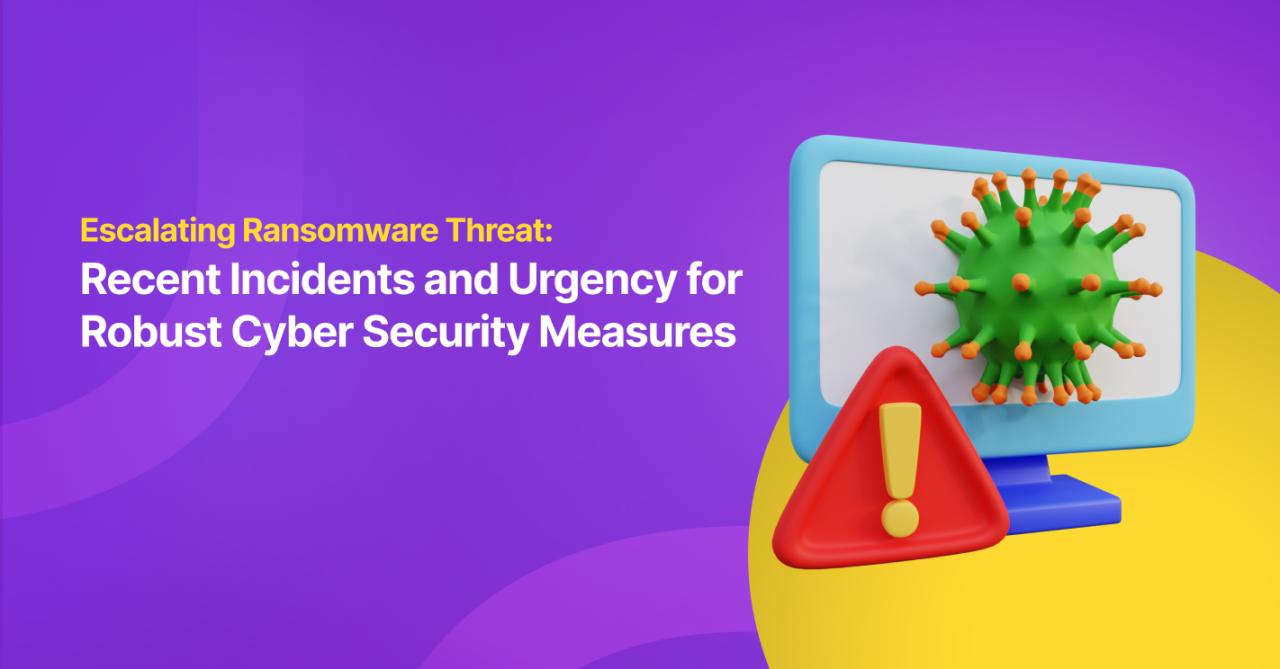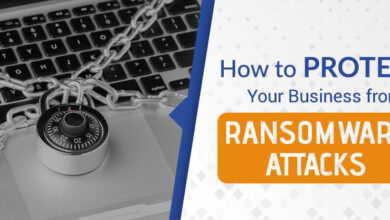
Can a Cyber Threat Abruptly Evolve into Ransomware?
Can a cyber threat abruptly evolve into a ransomware attack? Absolutely. It’s a terrifying scenario, but understanding how seemingly innocuous intrusions can escalate into full-blown ransomware deployments is crucial for effective cybersecurity. This isn’t about some far-off, theoretical risk; it’s a real-world danger that’s impacting businesses and individuals daily. We’ll explore the stages of this evolution, from initial infection vectors to the chilling finality of data encryption and ransom demands, shedding light on the attacker’s methods and offering practical steps to mitigate the threat.
The journey from a simple network breach to a crippling ransomware attack often involves a series of carefully orchestrated steps. Attackers might begin with seemingly benign phishing emails or exploit vulnerabilities in outdated software. Once inside, they work stealthily, moving laterally through the network, escalating privileges to gain administrator-level access. Only then do they unleash the ransomware, encrypting crucial data and demanding a ransom for its release.
This methodical approach highlights the importance of robust security measures at every stage of the process.
Initial Infection Vectors
The initial compromise of a system is the crucial first step in any ransomware attack. Understanding how attackers gain this initial access is vital for effective prevention. This involves identifying common attack vectors, recognizing the differences between targeted and opportunistic approaches, and understanding the attacker’s post-infection actions.
Ransomware attacks rarely occur spontaneously. They’re the culmination of a deliberate process, often beginning with seemingly innocuous actions. The methods employed can range from sophisticated, targeted campaigns to opportunistic exploitation of known vulnerabilities. The likelihood of an infection progressing to full-blown ransomware deployment depends heavily on the attacker’s goals, the victim’s security posture, and a degree of luck.
Common Initial Infection Vectors
Several methods are commonly used to initially compromise a system, potentially leading to a ransomware attack. The table below Artikels some of the most prevalent vectors, their descriptions, examples, and the likelihood of them progressing to a full ransomware deployment.
| Vector Type | Description | Example | Likelihood of Ransomware Progression |
|---|---|---|---|
| Phishing Emails | Malicious emails containing attachments or links designed to trick recipients into executing malicious code. | An email appearing to be from a legitimate bank or service provider, prompting the user to click a link or open a malicious attachment. | High – Phishing is a very common initial infection vector, often used in ransomware campaigns due to its effectiveness. |
| Exploiting Software Vulnerabilities | Leveraging known vulnerabilities in software applications or operating systems to gain unauthorized access. | Exploiting a vulnerability in a web server to gain access and deploy ransomware. The NotPetya ransomware attack leveraged the EternalBlue exploit. | Medium to High – Depends on the vulnerability’s severity and the attacker’s capability. Critically vulnerable systems are at high risk. |
| Malicious Software Downloads | Downloading and installing malicious software disguised as legitimate programs. | Downloading a cracked software from a torrent site that contains ransomware. | High – Often users are unaware they are installing malicious software. |
| Remote Desktop Protocol (RDP) Brute-forcing | Attempting to gain access to a system via RDP by trying various username and password combinations. | Attackers using automated tools to guess RDP credentials on systems with weak passwords or default credentials. | Medium to High – Successful brute-forcing can provide direct access to the system. |
| Supply Chain Attacks | Compromising a software supplier or other part of the supply chain to distribute malware to many targets. | Compromising a widely used software update mechanism to deliver ransomware to many users. The SolarWinds attack is a prime example. | Very High – These attacks can impact a large number of systems simultaneously. |
Targeted vs. Opportunistic Attacks
Ransomware attacks can be broadly categorized as targeted or opportunistic. Targeted attacks focus on specific organizations or individuals, often employing sophisticated techniques and extensive reconnaissance. Opportunistic attacks, conversely, cast a wider net, exploiting vulnerabilities in any accessible system.
Targeted attacks often involve extensive pre-attack reconnaissance, identifying valuable data and potential vulnerabilities within the target’s network. This allows for a more precise and effective deployment of ransomware, maximizing the potential for a high ransom payout. Opportunistic attacks, on the other hand, rely on mass-scale deployment, hoping to find vulnerable systems that can be easily compromised. While the potential payout per victim might be lower, the sheer number of potential victims can lead to significant overall gains.
Establishing a Foothold
Once an attacker gains initial access, they typically take several steps to establish a more permanent foothold before deploying ransomware. This often involves actions designed to maintain persistence, elevate privileges, and move laterally within the network.
These steps might include creating backdoors, disabling security software, escalating privileges to gain administrator-level access, and mapping the network to identify high-value targets. The attacker might also deploy tools to exfiltrate sensitive data, creating leverage for a higher ransom demand or for blackmail purposes. The goal is to gain complete control of the system before deploying the ransomware payload to ensure successful encryption and maximum impact.
Lateral Movement and Privilege Escalation: Can A Cyber Threat Abruptly Evolve Into A Ransomware Attack
Once an attacker gains initial access to a network, the next phase is to expand their control. This involves lateral movement—moving from the initially compromised system to other systems within the network—and privilege escalation—gaining higher-level access rights. This broadened access allows attackers to deploy ransomware more effectively and potentially exfiltrate sensitive data undetected. The goal is to reach systems with valuable data or those with administrative privileges, making ransomware deployment and data encryption far easier.Lateral movement and privilege escalation are critical steps in a successful ransomware attack.
Without these, the attacker’s initial foothold might be quickly discovered and remediated before significant damage is done. Understanding these techniques is crucial for building robust network security defenses.
Yes, a seemingly minor cyber threat can absolutely escalate into a full-blown ransomware attack; it’s a terrifyingly common scenario. Understanding how to mitigate this requires a robust security posture, which is why I’ve been digging into the details of bitglass and the rise of cloud security posture management , as it offers a powerful way to prevent such escalations.
Ultimately, proactive cloud security is key to stopping a small breach from turning into a major ransomware disaster.
Lateral Movement Techniques
Attackers employ various methods to move laterally within a compromised network. These techniques often exploit vulnerabilities in network protocols, misconfigurations, or weak security practices. Successfully moving laterally often involves using a combination of techniques.
- Pass-the-Hash: This technique involves stealing and reusing the password hashes of compromised accounts to access other systems without needing the actual passwords. This is particularly effective against systems using older authentication protocols.
- Credential Stuffing/Spraying: Attackers use lists of known usernames and passwords (often obtained from data breaches) to attempt logins on multiple systems. Successful attempts provide access to additional systems.
- Exploiting Network Shares: Attackers can leverage vulnerable network shares to access and copy files, potentially including credentials or other sensitive information. Poorly configured file permissions often contribute to this.
- Using Remote Access Tools: Compromised systems can be used to install and utilize remote access tools (RATs) like TeamViewer or AnyDesk, granting the attacker control over other systems within the network.
- Moving via VPNs: Attackers might leverage access to VPN gateways or internal VPN connections to move between network segments more easily, masking their origin.
Privilege Escalation Methods
After establishing a foothold, attackers need higher privileges to deploy ransomware effectively. Administrator-level access allows them to install malware, encrypt files without restriction, and disable security measures.
- Exploiting Software Vulnerabilities: Attackers can use known vulnerabilities in applications or operating systems to gain elevated privileges. These vulnerabilities often allow for execution of arbitrary code with higher privileges.
- Using Weak or Default Passwords: If administrator accounts have weak or default passwords, they can be easily guessed or cracked using brute-force attacks.
- Exploiting Misconfigurations: Incorrectly configured systems or services can unintentionally grant elevated privileges. For example, a service running with excessive permissions might be exploited.
- Using Local Privilege Escalation Exploits: These exploits target vulnerabilities within the operating system itself, enabling attackers to gain administrator privileges on a compromised machine.
- Abusing Domain Trusts: In enterprise environments, attackers might leverage trust relationships between domains to gain access to higher-privileged accounts in other domains.
Hypothetical Ransomware Deployment Scenario
Imagine a small business with a poorly secured network. An attacker gains initial access via a phishing email containing a malicious attachment. This attachment installs a backdoor on a marketing employee’s workstation. The attacker then uses pass-the-hash to gain access to a domain controller. From the domain controller, they leverage a known vulnerability (unpatched) to elevate their privileges to Domain Administrator.
With these elevated privileges, the attacker deploys ransomware across the entire network, encrypting crucial files and demanding a ransom. The attacker may also exfiltrate sensitive data before encrypting to increase pressure on the victim.
Ransomware Deployment Techniques

Understanding how ransomware is deployed is crucial for effective prevention and mitigation. Attackers employ a range of sophisticated methods, often combining multiple techniques to maximize their chances of success and to evade detection. These methods leverage vulnerabilities in systems and human behavior, making a multi-layered defense strategy essential.
The deployment of ransomware is a multifaceted process, often involving a chain of events starting with initial access and culminating in the encryption of valuable data. The specific techniques used can vary widely depending on the ransomware family, the target, and the attacker’s resources and expertise. However, several common threads connect many successful ransomware attacks.
Ransomware Deployment Methods
Attackers utilize a variety of methods to deploy ransomware, each exploiting different vulnerabilities in systems and human behavior. These methods often work in concert, with one technique facilitating the next.
- Exploits: Attackers actively seek and exploit vulnerabilities in software, operating systems, and applications. This might involve using publicly known vulnerabilities (zero-day exploits are rarer due to their cost and difficulty) to gain initial access to a system. Once inside, they can move laterally and escalate privileges before deploying the ransomware payload.
- Social Engineering: This involves manipulating individuals into performing actions that compromise security. Phishing emails containing malicious attachments or links, pretexting (pretending to be someone else to gain trust), and baiting (luring victims with enticing offers) are common social engineering tactics used to deliver ransomware. The success of these attacks often relies on exploiting human psychology and lack of security awareness.
- Malware Delivery Mechanisms: Ransomware can be delivered through various channels. This includes malicious email attachments (often disguised as invoices or other legitimate documents), compromised websites that download ransomware when visited, infected software downloads from untrusted sources, and removable media (USB drives) containing malicious code. Drive-by downloads, where malware is automatically downloaded without user interaction, are also a significant threat.
- Software Vulnerabilities: Outdated or unpatched software represents a significant entry point for ransomware. Attackers often exploit known vulnerabilities in applications like Adobe Flash, Java, and older versions of Microsoft Office to gain initial access and deploy their payload. Regular software updates and patching are critical preventative measures.
- Remote Desktop Protocol (RDP) Brute-forcing: Attackers frequently attempt to brute-force RDP credentials to gain access to systems. Weak or default passwords make systems particularly vulnerable to this type of attack. Strong passwords and multi-factor authentication are essential defenses against RDP brute-forcing.
Comparison of Ransomware Families and Deployment Strategies
Different ransomware families employ distinct deployment strategies, reflecting the sophistication and resources of their creators. While some rely on simpler methods like phishing emails, others leverage advanced techniques like exploit kits and sophisticated malware delivery mechanisms.
For example, Ryuk ransomware, known for its high payout and targeting of large organizations, often relies on initial access through other malware infections, such as Trickbot, before deploying its payload. In contrast, WannaCry, which caused widespread disruption in 2017, leveraged the EternalBlue exploit to spread rapidly across vulnerable systems. This highlights the diversity of techniques employed and the need for a comprehensive security approach.
Indicators of Compromise (IOCs) Suggesting Imminent Ransomware Deployment
Identifying potential ransomware attacks before they fully deploy is crucial for minimizing damage. Several indicators of compromise (IOCs) can suggest that a ransomware attack is imminent or underway.
- Unusual network activity: A sudden surge in outbound network connections, especially to unfamiliar IP addresses or domains, could indicate malicious activity. This might involve data exfiltration or communication with a command-and-control server.
- Suspicious processes: The appearance of unknown or unusual processes running on systems can be a strong indicator of compromise. These processes might be associated with ransomware encryption or data exfiltration activities.
- Encrypted files: The presence of files with unusual extensions or characteristics indicative of encryption (e.g., a significant increase in file sizes or changes to file attributes) suggests that ransomware may already be active.
- Ransom notes: The appearance of ransom notes demanding payment in exchange for decryption keys is a clear indication that a ransomware attack has been successful.
- Unusual login attempts: A large number of failed login attempts from unusual locations or times might suggest a brute-force attack attempting to gain access to systems. This could be a precursor to ransomware deployment.
Data Exfiltration and Encryption
Data exfiltration and encryption are critical phases in a ransomware attack. Attackers often prioritize stealing sensitive data before or after encryption, either for leverage (to pressure victims into paying the ransom) or for their own malicious purposes. The encryption process itself, while seemingly straightforward, involves a complex interplay of algorithms and techniques designed to render data inaccessible. Understanding these processes is crucial for effective prevention and response.
The methods used for data exfiltration vary widely, depending on the attacker’s resources and the victim’s network infrastructure. These techniques range from simple file transfers to sophisticated covert channels. Simultaneously, the choice of encryption algorithm significantly impacts the ransomware’s resilience and the difficulty of decryption.
Data Exfiltration Methods
Several methods exist for exfiltrating data, each with varying degrees of effectiveness and detectability. The choice often depends on the attacker’s goals, resources, and the target’s security posture.
| Method | Effectiveness | Detection Challenges |
|---|---|---|
| File Transfer Protocol (FTP) | Moderately effective; easily detectable with proper network monitoring. | Easy to detect with intrusion detection systems (IDS) and Security Information and Event Management (SIEM) systems, especially with suspicious file transfers outside normal business hours or to unusual destinations. |
| Cloud Storage Services | Highly effective; difficult to detect without comprehensive monitoring of cloud activity. | Requires advanced threat detection solutions that monitor cloud storage APIs and activity logs. Detection relies on anomaly detection based on unusual data transfer volumes or file types. |
| Moderately effective; can be detected with email security solutions. | Detection relies on email gateways and security solutions scanning for malicious attachments or suspicious links. Advanced techniques like using steganography can make detection challenging. | |
| Remote Access Tools (RATs) | Highly effective; often undetectable without dedicated monitoring. | Detection requires advanced endpoint detection and response (EDR) solutions, network traffic analysis, and behavioral monitoring to identify suspicious processes and communication patterns. |
Encryption Algorithms Used in Ransomware
Ransomware authors often employ strong encryption algorithms to ensure the encrypted data remains inaccessible without the decryption key. The resilience of these algorithms directly impacts the difficulty of recovery.
Commonly used algorithms include AES (Advanced Encryption Standard), RSA (Rivest-Shamir-Adleman), and variations thereof. AES, particularly in its 256-bit form, is considered highly secure, making brute-force attacks computationally infeasible. RSA is often used for key exchange and digital signatures, adding another layer of security. The strength of the encryption is also influenced by the implementation details and the key management practices.
While some ransomware may use weaker algorithms, making decryption more feasible, many sophisticated attacks rely on robust algorithms that significantly hinder recovery efforts without the decryption key.
Ransomware Encryption Process
The encryption process typically involves several steps, starting with target identification and culminating in the encryption of files. The specific steps may vary slightly depending on the ransomware variant, but the overall process remains consistent.
- Target Identification: The ransomware identifies target files based on file extensions, file types, or specific file paths. This often involves scanning the system for valuable data.
- Key Generation: A unique encryption key is generated. This key is crucial for both encryption and decryption. Sophisticated ransomware may employ asymmetric encryption, using a public key for encryption and a private key for decryption.
- File Encryption: The identified files are then encrypted using the generated key and the chosen algorithm. The encryption process may be performed in parallel to accelerate the process.
- Ransom Note Creation: A ransom note is created, instructing the victim on how to pay the ransom and obtain the decryption key. This note may include details about the encryption algorithm used and other relevant information.
- Key Exfiltration (Optional): In some cases, the encryption key may be exfiltrated to a remote server controlled by the attackers. This allows them to retain control and potentially decrypt the data even if the victim doesn’t pay the ransom.
- Encryption Completion: Once the encryption process is complete, the ransomware may delete shadow copies and other backups to hinder recovery efforts.
Ransom Note and Communication

The ransom note is the attacker’s final communication, a chilling culmination of their cyberattack. It serves as both a declaration of success and a pressure tactic, aiming to coerce the victim into paying the ransom. The content and delivery method are carefully chosen to maximize the impact and increase the likelihood of payment. Understanding these elements is crucial for both prevention and response.The typical ransomware ransom note contains several key components.
It clearly states the type of attack that has occurred (e.g., data encryption), the amount of ransom demanded (often in cryptocurrency like Bitcoin), and a deadline for payment. Failure to meet the deadline usually results in a threat to delete the encrypted data or publicly release sensitive information. The note often includes instructions for payment, specifying the cryptocurrency wallet address, and may provide a decryption key or tool as proof of their ability to restore access.
The language used can range from impersonal and business-like to aggressive and threatening, depending on the attacker’s goals and the perceived vulnerability of the victim.
Ransom Note Contents and Demands
A typical ransom note will include the following information: a clear statement of what has been compromised (e.g., “Your files have been encrypted”), the amount of the ransom demanded (often stated in Bitcoin or another cryptocurrency), a deadline for payment, instructions for payment (including wallet address), and a threat of consequences for non-payment (e.g., data deletion or public release of sensitive information).
The ransom amount can vary wildly, from a few hundred dollars to millions, depending on the size and value of the compromised data, and the perceived financial strength of the victim. For example, a small business might face a ransom demand of a few thousand dollars, while a large corporation could face a demand in the millions. The deadline is usually short, creating a sense of urgency and pressure.
Communication Channels, Can a cyber threat abruptly evolve into a ransomware attack
Attackers utilize various channels to communicate their demands. Email is a common method, but they might also use messaging platforms like Telegram or even leave a ransom note directly on the compromised system. The choice of communication channel often depends on the attacker’s level of sophistication and their desire for anonymity. For example, using a less traceable messaging app like Telegram provides a degree of anonymity, while email, though easily monitored, might be preferred for its widespread accessibility.
Yes, a seemingly minor cyber threat can absolutely escalate into a full-blown ransomware attack. Security breaches often start subtly, and robust, secure application development is crucial. That’s why I’ve been researching the advancements in domino app dev, the low-code and pro-code future , to see how these methods can help build more resilient systems. Ultimately, preventing ransomware hinges on proactive security measures at every stage of application development and deployment, not just reacting after an attack.
The use of dark web forums is also common for attackers to share information, trade ransomware, and communicate with victims.
Sample Ransom Note and Psychological Manipulation
Below is an example of a ransom note, highlighting the psychological manipulation techniques employed.
Subject: Your Data is EncryptedYour files have been encrypted using military-grade encryption. We have full access to your data, and we are confident in our ability to permanently delete it if you fail to cooperate.The ransom is 1 Bitcoin, equivalent to approximately $20,000 at the current exchange rate. You must pay within 72 hours.Instructions for payment: Send 1 Bitcoin to the following address: [Bitcoin Address]Once the payment is confirmed, we will send you the decryption key.Failure to comply will result in the irreversible deletion of your data and potential public disclosure of your sensitive information. Time is of the essence. Act now.
This note employs several psychological manipulation tactics:* Fear of loss: The threat of data deletion creates immediate fear and urgency.
Scarcity
The short deadline reinforces the urgency and creates a sense of limited opportunity.
Authority
The use of phrases like “military-grade encryption” implies sophistication and power.
Social proof (implied)
The note suggests the attackers have successfully attacked others.
Impact and Mitigation Strategies
Ransomware attacks are devastating events that can cripple organizations of all sizes. The consequences extend far beyond the initial financial demand, impacting various aspects of an organization’s operations and reputation. Understanding these impacts is crucial for developing effective mitigation strategies. A proactive approach, focusing on prevention and preparedness, is significantly more cost-effective than dealing with the aftermath of an attack.The impact of a successful ransomware attack can be far-reaching and long-lasting, significantly affecting an organization’s bottom line and overall stability.
It’s not just about the ransom payment; the ripple effects can be devastating.
Impacts of a Ransomware Attack
The consequences of a ransomware attack are multifaceted and can severely impact an organization’s ability to function effectively. These impacts can be categorized into financial, reputational, and operational disruptions. Failing to address these vulnerabilities leaves your organization exposed to significant risks.
- Financial Losses: This includes the ransom payment itself, costs associated with incident response (hiring cybersecurity experts, forensic analysis, legal fees), data recovery, system restoration, business interruption, and potential loss of revenue due to downtime.
- Reputational Damage: A ransomware attack can severely damage an organization’s reputation, leading to loss of customer trust, damage to brand image, and difficulty attracting new clients or investors. Public disclosure of a breach can be incredibly damaging.
- Operational Disruptions: Ransomware attacks can bring operations to a complete standstill. This includes disruption of critical business processes, loss of productivity, inability to access essential data, and potential legal liabilities due to data breaches.
Mitigation Strategies for Ransomware Attacks
Implementing a robust set of mitigation strategies is crucial for preventing and responding to ransomware attacks. A multi-layered approach combining technical controls, employee training, and incident response planning is essential. Remember, prevention is always better than cure. The cost of remediation far outweighs the investment in prevention.
| Strategy | Implementation Details |
|---|---|
| Security Awareness Training | Regular training programs for all employees on identifying and avoiding phishing emails, malicious links, and other social engineering tactics. Simulations and phishing campaigns can be effective in reinforcing training. Training should be tailored to different roles within the organization. |
| Regular Patching | Implement a robust patching policy that addresses vulnerabilities in software and operating systems promptly. Utilize automated patching tools where possible and regularly scan for vulnerabilities. Prioritize patching critical systems and applications first. |
| Data Backups | Implement a comprehensive backup and recovery strategy, including regular backups of critical data to offline storage. Test backups regularly to ensure data recoverability. The 3-2-1 backup rule (3 copies of data, 2 different media types, 1 offsite location) is a good guideline. |
| Network Segmentation | Segment the network into smaller, isolated zones to limit the impact of a breach. If one segment is compromised, the attacker’s lateral movement is restricted. |
| Multi-Factor Authentication (MFA) | Implement MFA for all user accounts, especially those with administrative privileges. This adds an extra layer of security, making it more difficult for attackers to gain unauthorized access. |
| Endpoint Detection and Response (EDR) | Deploy EDR solutions to monitor endpoint devices for malicious activity. EDR solutions can detect and respond to ransomware attacks in real-time, minimizing the impact. |
| Security Information and Event Management (SIEM) | Utilize a SIEM system to collect and analyze security logs from various sources. This provides a centralized view of security events and helps identify potential threats early on. |
Ultimate Conclusion
The evolution of a cyber threat into a ransomware attack is a chillingly efficient process, often unfolding silently until it’s too late. While the methods employed by attackers are constantly evolving, understanding the common stages—initial infection, lateral movement, ransomware deployment, data exfiltration, and the final ransom demand—is key to effective prevention and mitigation. By implementing proactive security measures, staying vigilant, and investing in robust security solutions, we can significantly reduce our vulnerability and minimize the devastating impact of a ransomware attack.
Remember, preparedness is your best defense against this ever-evolving threat.
Question Bank
What types of data are most commonly targeted by ransomware?
Ransomware typically targets critical data, including financial records, customer databases, intellectual property, and operational documents. Anything that would cause significant disruption or financial loss to the victim is a prime target.
How can I tell if my system has been infected with ransomware?
Signs of ransomware infection include unusual file extensions, encrypted files, ransom notes appearing on your screen, and unusual network activity. Look for unexplained slowdowns or system crashes, too.
Should I pay the ransom?
Paying the ransom is generally not recommended. There’s no guarantee you’ll get your data back, and you’ll be encouraging further attacks. Focus on data recovery from backups and reporting the incident to the authorities.
What is the role of social engineering in ransomware attacks?
Social engineering plays a significant role, often as the initial infection vector. Attackers use deceptive tactics like phishing emails or phone calls to trick users into providing access or downloading malicious software.





